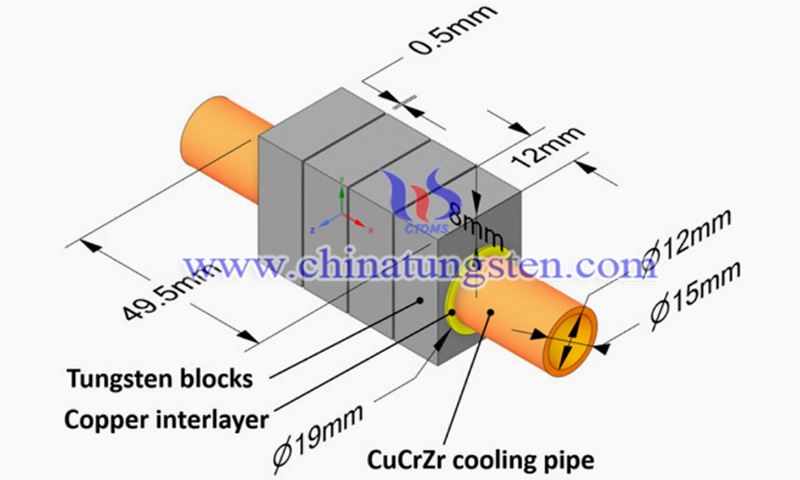Tungsten X-Ray Breakthroughs Advances Nuclear Fusion
- Details
- Category: Tungsten's News
- Published on Monday, 23 May 2022 13:28
JET is the world's largest fusion energy machine. Based on the same process that powers our sun and the stars, nuclear fusion has long been considered the ultimate energy source. A new paper reveals how tungsten parts can now be successfully scanned with tungsten X-rays to help detect defects and accurately determine their lifetimes in order to advance fusion.
JET is very durable and can handle intense conditions. Tungsten is the strongest of all-natural metals, only diamonds can leave scratches on its surface. This unique quality makes it the perfect material for the inside of a fusion energy machine, where the temperature is 10 times higher than the sun's core. That's 150 million degrees Celsius, the hottest place in our solar system.

(Credit: Heather Lewtas/Nucl. Fusion)
As durable as tungsten is, withstanding such intense in-vessel neutron bombardment during fusion could eventually compromise reliability and cause wear and tear, especially in power plants that operate around the clock. Until now, engineers and scientists have not had a reliable way to detect potential structural damage (normal 3-D X-ray scans cannot penetrate due to the incredible density of tungsten).
However, a new paper published by scientists at the UK Atomic Energy Authority (UKAEA) reveals for the first time how tungsten parts can now be successfully scanned with X-rays to help detect defects and accurately determine their lifespan.
This is an important step on the roadmap to commercial power for nuclear fusion, as structural analysis and lifetimes are a significant barrier to providing humanity with this safe, sustainable, low-carbon form of energy.
This study was published in Nucl. Fusion 2022 (62). Heather Lewtas, Head of Innovation at UKAEA, and co-author of the paper "Are tungsten-based fusion components truly invisible to x-ray inspection?" explain the implications of their research at Culham, Oxford, explain the significance of their research.

(Credit: Heather Lewtas/Nucl. Fusion)
“Nuclear fusion promises to be a safe, low-carbon and sustainable part of the world's future energy supply," she said. “Its predictability is one of its main advantages, but it is, therefore, crucial that the power plant is not decommissioned for unnecessary maintenance. This groundbreaking research gives us confidence that we will be able to assess the condition of our tungsten components, which must repeatedly withstand the most challenging conditions on Earth."
"This advancement minimizes future power plant downtime. This is an important step forward and we are very proud to be demonstrating this technology for the first time."
The experimental tungsten X-ray study, led by scientist Triestino Minniti and completed under the UKAEA Fusion Technology Facilities programme, uses emerging technologies. Putting fusion power on the grid economically and reliably requires technical solutions to several challenges, and UKAEA is conducting cutting-edge research in each category of innovation through its world-leading facilities.
Heather added, "We need to make significant changes to address the effects of climate change, and nuclear fusion offers so much potential that it has the potential to provide 'baseload' electricity and help maintain net-zero emissions in the second half of this century. Groundbreaking research and innovation in the UK is taking us step by step closer to this exciting roadmap for commercial electricity."
Based on the same processes that power our sun and stars, fusion has long been considered the ultimate energy source. Fusion is rightfully difficult, but here are the basics. When a mixture of two forms of hydrogen (deuterium and tritium) is heated to extreme temperatures (10 times hotter than the sun's core), they fuse together, producing helium and releasing large amounts of energy in the form of heat.
This superheated material forms a plasma, the fourth state of matter found in lightning and neon. There is more than one way to achieve fusion. At UKAEA, they use strong magnets to hold this hot plasma in a circular machine known as a tokamak. The energy produced by nuclear fusion can generate electricity similar to that of existing power stations, which run steam turbines by boiling water into steam.
- Tungsten Manufacturer & Supplier, Chinatungsten Online: www.chinatungsten.com
- Tungsten News & Prices of China Tungsten Industry Association: www.ctia.com.cn
- Molybdenum News & Price: news.molybdenum.com.cn
- Tel.: 86 592 5129696; Fax: 86 592 5129797; Email: sales@chinatungsten.com



 sales@chinatungsten.com
sales@chinatungsten.com